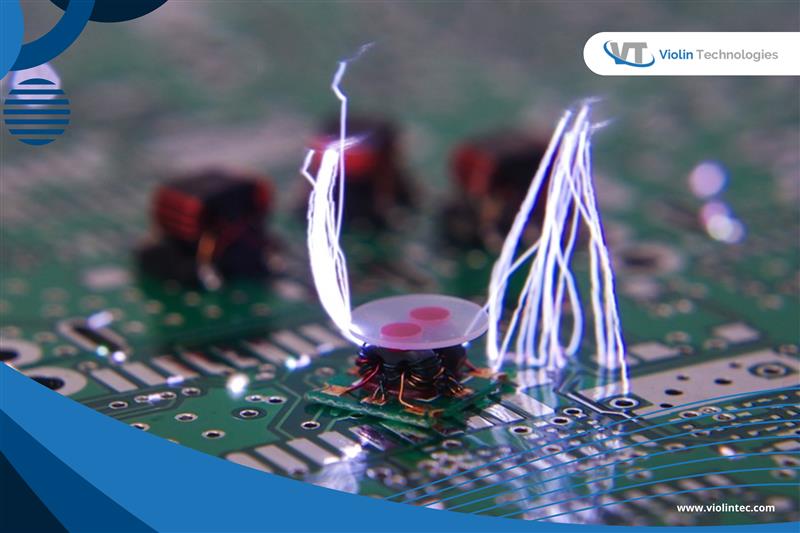So, what makes ESD such a threat, and why is integrating ESD protection into circuit board design essential? Let’s explore the answers, from the root causes and dangers to effective strategies that keep your electronics safe.
What is Electrostatic Discharge (ESD)?
ESD is the sudden transfer of static electricity from one object to another, typically when they come into contact or proximity. If you’ve ever felt a zap after touching a metal doorknob on a dry day, you have experienced ESD on a human scale. These everyday shocks might seem harmless, but on the microcosmic scale of circuit boards, even much smaller voltage spikes can wreak havoc.
The Hidden Dangers of ESD on Circuit Boards
While ESD is usually imperceptible, the consequences for an unprotected circuit board can be dire. Here’s why:
- Component Damage: Many integrated circuits (ICs) and semiconductor components on modern boards are built with features just a fraction of a micron thick. These are incredibly sensitive to sudden voltage surges. For instance, an ESD jolt as little as 30 volts can damage a device, while humans generally only feel shocks above 2,000 volts!
- Latent Failures: Sometimes, ESD doesn’t immediately “kill” a component. Instead, it causes subtle damage, weakening the part so that it fails prematurely in the field. These failures are notoriously hard to diagnose and can seriously impact reliability and reputation.
- Data Corruption: ESD coupling can flip data bits or cause unpredictable processor behavior, posing a particular risk in safety-critical or mission-critical environments.
- Production Yield Loss: ESD incidents during manufacturing can result in the scrapping of entire lots of boards or lead to costly re-testing and remanufacturing.
Why ESD Protection Is Crucial at Every Stage
ESD protection isn’t just a “nice-to-have” for exotic or high-end electronics, it’s an essential safeguard for ANY device operating in the real world. Here’s why:
1. Ensures Product Reliability and Longevity
Without robust ESD protection, electronics may function properly in the factory but fail unexpectedly when deployed. This leads to increased returns, dissatisfied customers, and high warranty costs. ESD-resistant designs deliver long-term reliability, protecting both devices and the reputation of the makers.
2. Industry Standards and Compliance
Organizations like IEC (International Electrotechnical Commission), ANSI, and JEDEC mandate ESD standards for consumer and industrial devices. Products that don’t meet these standards cannot be legally sold in many markets. Integrating ESD safeguards early in the design process keeps development costs lower and compliance simpler.
3. Reduces Cost of Failure
Catching ESD vulnerabilities in the field (after production) is vastly more expensive than addressing them at the board design stage. ESD failures can necessitate product recalls, on-site repairs, or extensive QC overhaul.
4. Safeguards Data Integrity
Devices handling sensitive information—such as medical records, financial transactions, or industrial controls—depend on uncompromised, stable operations. ESD events can cause random resets, corrupted memory, or unpredictable glitches.
5. Protects During Manufacturing, Handling, and Use
ESD risks are present not just when the end-user opens the box, but throughout the entire device lifecycle:
- During PCB assembly and soldering
- testing and programming
- During transport and shipment
- Through end-user handling in unpredictable environments.
Designing for ESD immunity covers all these bases.
Expert electromechanical assemblies and box builds manufacturers streamline your production and improve quality while providing affordable and customizable solutions for any industry.

How is ESD Protection Implemented on Circuit Boards?
Protecting against ESD starts with a multi-layered approach, combining good design habits with proven hardware solutions.
1. Circuit Design Best Practices
- PCB Layout: Keep sensitive signal traces short, avoid running them near board edges, and use ground planes to shield critical paths.
- Component Placement: Place vulnerable ICs away from connectors where ESD might enter.
- Grounding Strategy: Design robust ground connections and ensure low resistance return paths for ESD events.
2. Use of ESD Protection Devices
- TVS (Transient Voltage Suppression) Diodes: Act as extremely fast clamping devices, absorbing ESD energy before it can damage chips.
- ESD Suppressors: Specialized devices that offer extremely high resistance under normal conditions but become conducting during a voltage spike to shunt ESD to ground safely.
- Ferrite Beads and Filter Networks: Block fast transients and prevent ESD energy from propagating deep into circuits.
3. Shielding and Enclosure Design
- Conductive Enclosures: Metal chassis or shields can absorb and redirect ESD away from sensitive electronics.
- Connector Design: Choose connectors with built-in ESD mitigation features and ensure proper grounding.
4. Manufacturing and Handling Controls
- ESD-Safe Workstations: Employ ESD mats, wrist straps, and ionizers in factories.
- Proper Training: Educate assembly line staff and handlers on ESD precautions and detection.
The Evolving Landscape of ESD Threats
As electronics expand into new applications—such as wearables, automotive, industrial, medical, and more—the environments in which they operate become more unpredictable and more challenging for ESD control. Each new use case brings unique ESD vulnerabilities. Engineers must routinely update protection methods as both technology and use contexts shift.
Increase your business with the best contract manufacturing partners, who provide customized, superior, and cost-effective solutions for all sectors.
Conclusion
Electrostatic discharge may seem like a mundane threat, yet it represents one of the most significant reliability and safety challenges faced by circuit board designers. Only a comprehensive, thoughtful approach—incorporating robust hardware protection, smart layout choices, and disciplined manufacturing practices—guarantees that our electronics endure the real world’s countless shocks and surprises.
By prioritizing ESD protection from the outset, manufacturers are not only safeguarding their products; they are laying the foundation for safer, longer lasting, and more dependable electronics in every aspect of life. In our electrified world, that’s a legacy worth
FAQs
1. What does ESD protection do for circuit boards?
It keeps delicate parts safe from static electricity that can damage or weaken them.
2.Why can static electricity harm a circuit board?
Even a tiny static zap can break tiny chips or make parts fail sooner than expected.
How do you protect a circuit board from ESD?
Use special protective components, such as ESD diodes, and follow a careful layout. Handle boards with anti-static tools.
When should you think about ESD protection during manufacturing?
From design to shipping, ESD safety should be a priority at every stage to ensure electronics function properly.

